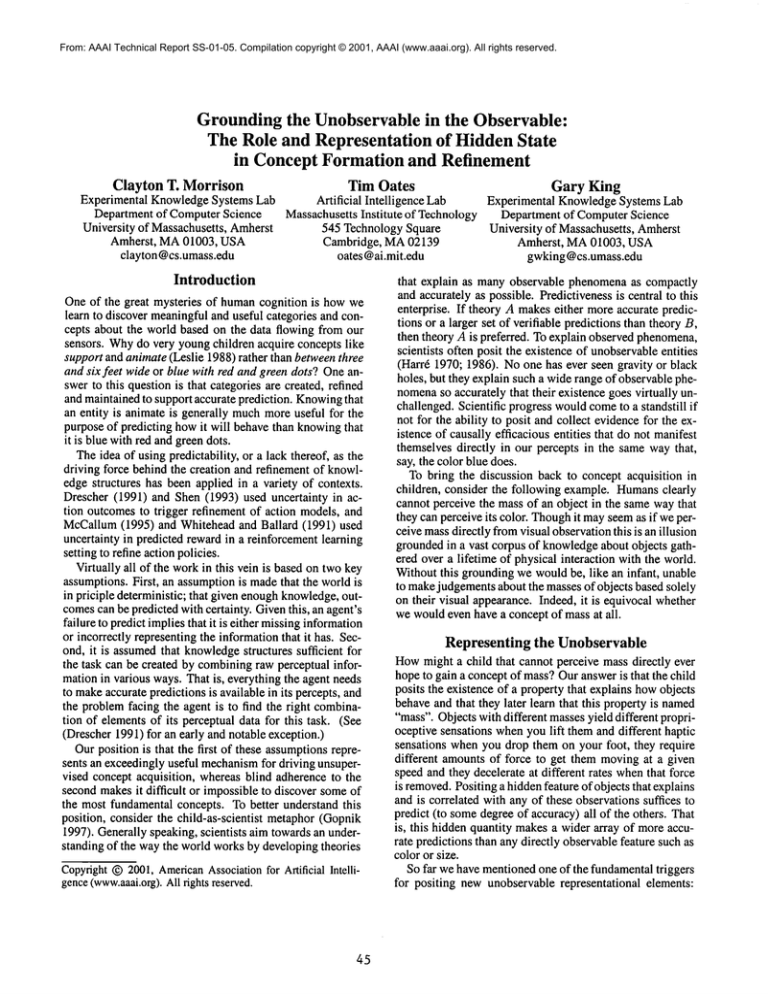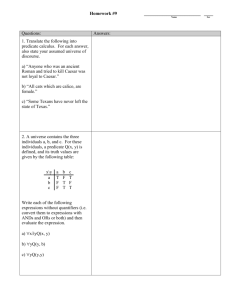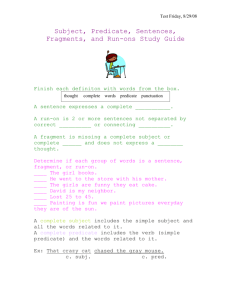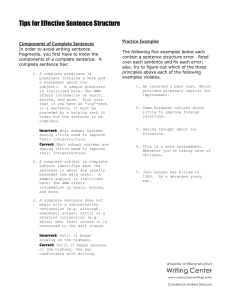
From: AAAI Technical Report SS-01-05. Compilation copyright © 2001, AAAI (www.aaai.org). All rights reserved.
Grounding the Unobservable in the Observable:
The Role and Representation of Hidden State
in Concept Formation and Refinement
ClaytonT. Morrison
Tim Oates
Gary King
Experimental KnowledgeSystems Lab
Artificial Intelligence Lab
Experimental KnowledgeSystems Lab
Department of ComputerScience
MassachusettsInstitute of Technology Department of ComputerScience
University of Massachusetts, Amherst
545 Technology Square
University of Massachusetts, Amherst
Amherst, MA01003, USA
Cambridge, MA02139
Amherst, MA01003, USA
clayton @cs.umass.edu
oates @ai.mit.edu
gwking@cs.umass.edu
Introduction
One of the great mysteries of humancognition is how we
learn to discover meaningfuland useful categories and concepts about the world based on the data flowing from our
sensors. Whydo very youngchildren acquire concepts like
support and animate (Leslie 1988) rather than betweenthree
and six feet wide or blue with red and green dots? Oneanswerto this question is that categories are created, refined
and maintainedto support accurate prediction. Knowingthat
an entity is animate is generally muchmoreuseful for the
purpose of predicting howit will behave than knowingthat
it is blue with red and green dots.
The idea of using predictability, or a lack thereof, as the
driving force behind the creation and refinement of knowledge structures has been applied in a variety of contexts.
Drescher (1991) and Shen (1993) used uncertainty in
tion outcomesto trigger refinement of action models, and
McCallum(1995) and Whitehead and Ballard (1991)
uncertainty in predicted reward in a reinforcement learning
setting to refine action policies.
Virtually all of the workin this vein is basedon two key
assumptions.First, an assumptionis madethat the world is
in priciple deterministic; that given enoughknowledge,outcomescan be predicted with certainty. Giventhis, an agent’s
failure to predict implies that it is either missinginformation
or incorrectly representing the informationthat it has. Second, it is assumedthat knowledgestructures sufficient for
the task can be created by combiningraw perceptual information in various ways. That is, everything the agent needs
to makeaccurate predictions is available in its percepts, and
the problemfacing the agent is to find the right combination of elements of its perceptual data for this task. (See
(Drescher 1991) for an early and notable exception.)
Our position is that the first of these assumptionsrepresents an exceedingly useful mechanismfor driving unsupervised concept acquisition, whereas blind adherence to the
secondmakesit difficult or impossible to discover someof
the most fundamental concepts. To better understand this
position, consider the child-as-scientist metaphor(Gopnik
1997). Generally speaking, scientists aim towards an understanding of the way the world works by developing theories
CopyrightO2001, American
Associationfor Artificial Intelligence(www.aaai.org).
All rights reserved.
45
that explain as manyobservable phenomenaas compactly
and accurately as possible. Predictiveness is central to this
enterprise. If theory A makeseither more accurate predictions or a larger set of verifiable predictions than theory B,
then theory A is preferred. To explain observed phenomena,
scientists often posit the existence of unobservableentities
(Harr6 1970; 1986). No one has ever seen gravity or black
holes, but they explain such a wide range of observable phenomenaso accurately that their existence goes virtually unchallenged. Scientific progress wouldcometo a standstill if
not for the ability to posit and collect evidencefor the existence of causally efficacious entities that do not manifest
themselves directly in our percepts in the same way that,
say, the color blue does.
To bring the discussion back to concept acquisition in
children, consider the following example. Humansclearly
cannot perceive the massof an object in the sameway that
they can perceive its color. Thoughit mayseemas if we perceive massdirectly fromvisual observationthis is an illusion
groundedin a vast corpus of knowledgeabout objects gathered over a lifetime of physical interaction with the world.
Withoutthis grounding we wouldbe, like an infant, unable
to makejudgementsabout the masses of objects based solely
on their visual appearance. Indeed, it is equivocal whether
we wouldeven have a concept of mass at all.
Representingthe Unobservable
Howmight a child that cannot perceive mass directly ever
hope to gain a concept of mass?Our answeris that the child
posits the existence of a property that explains howobjects
behaveand that they later learn that this property is named
"mass". Objects with different massesyield different proprioceptive sensations whenyou lift them and different haptic
sensations whenyou drop them on your foot, they require
different amounts of force to get them movingat a given
speed and they decelerate at different rates whenthat force
is removed.Positing a hiddenfeature of objects that explains
and is correlated with any of these observations suffices to
predict (to somedegree of accuracy) all of the others. That
is, this hidden quantity makesa wider array of moreaccurate predictions than any directly observablefeature such as
color or size.
So far we have mentionedone of the fundamentaltriggers
for positing new unobservable representational elements:
failure to predict. But an account of howthe neonate human
or machinemight support the acquisition of knowledgeof
these hiddenstates requires a representational infrastructure
that can
¯ accommodate
recognition of failure to predict, and
¯ accommodaterepresentations whose content is fundamentally reviseable and extendable.
The first property highlights that these representations must
provide somewayfor the agent to recognize that something
has gonewrong:its current representational repertoire fails
to be useful in predicting someaspect of the environment.
Thesecondproperty is a little morecomplicated.First, it
highlights that, in its intial, nakedform, the proposednew
representational element serves simply as a "place-marker"
associated with the context of the failure to anticipate some
aspect of the world. At this point, the agent does not even
knowwhether the new element represents a hidden state,
someunobservable property, or someunseen process. Next,
given the newelement, the agent must nowsearch for conditions underwhichit can reliably predict its state value. Once
these conditions are discovered,the state value of this representational element can then be used to makepredictions of
the the previously unpredictable aspects of the world. These
conditions are themselvesstates of the worldthat are directly
observable or can be accurately anticipated by the agent.
They are associated with the newly constructed representational element, serving as conditions for determiningits
state value. In this way, the content (the meaning)of the
proposed new representation of an unobservable aspect of
the world is fundamentallyrevisable and extendable.
Interestingly, a commontheme is shared amongseveral
computationalmodelsof representation learning along these
lines (e.g., (Drescher 1991; Kwok1995)). Namely,the
data structure for a representational unit in these discovery systemsis a triple involving preconditions, someaction,
and postconditions; following Drescher’s (1991) terminology, we will refer to this data structure as a schema(see
Figure 1).
carrying out an experiment). Irrespective of where along
the continuumfrom atomic/concrete to compound/abstract
these actions are specified, they all share in common
the key
property of affecting, in someway, what future input the
agent will receive from the world. In this view, there is no
such thing as a system that is purely disembodiedor passive with respect to the environmentit is learning about: the
world affects the agent and the agent affects the world (see
(Bickhard1993)). Furthermore, note that even "passive"
tions that don’t directly causally impingeon states of the
world, such as passively observing a scene, still involve an
"action" that affects the subsequentinput - e.g., passive observation specifically involves sitting still and not altering
states of the environmentwhile there is a passageof time.
Constructing a NewPredicate
Withinthis representational framework,it is nowpossible to
create (discover) newpredicates that maycorrespond to unobservable states or properties of the world. Thesenewpredicates are then useful for deterministically predicting previously unpredictable behavior of the world. Following the
base representational form of the schema, and using a "just
so" story involving the dicoveryof a mass-like concept, such
creation and discovery works as follows:
Initially, the agent does not knowhowto predict the outcomesof actions or interactions involving objects and such
diverse outcomesas proprioreceptive feedback whenlifting
an object, haptic feedback whenthe object is dropped on
one’s foot, the force required to achieve somevelocity in
movingthe object, and the rate of deceleration of the object
whenone stops pushing. Instead, the different outcomesof
these events are simply experienced as they happen. Figure 2 depicts a pair of schemasrepresenting two different
experiencesof lifting objects that are otherwiseperceptually
identical (also in conditionsthat are essentially identical).
Lift Object
I
Action
,.@
Lift Object
Figure 1: Base structure of representation - preconditions,
action, postconditions.
The preconditions and postconditions initially consist of
sets of predicates whosevalues represent directly observable
states of the world (e.g., colors, shapes, relative positions
of visual objects in the retinal field), and later mayinclude
newlylearned states (e.g., states that are not directly observable, including newrepresentational elements whosevaluedetermining conditions have already been learned). The
actions can be simple physical-motor actions (e.g., opening one’s mouth), or more abstracted activities that themselves consist of a structured set of composedactions (e.g.,
46
Figure 2: Initial set of schemaswith outcomesthat are not
predictable based on the observable preconditions.
As is clear from the schemasin Figure 2, the agent does
not have enoughinformation to properly anticipate what will
happenwhen lifting the small object in the two different
cases. Sometimessmall objects require a high amountof
musclestrain in order to be lifted, other times they do not.
This inability to anticipate what will happenserves as the
trigger for the agent to propose a new predicate, P1, whose
values will help distinguish betweenthe two situations (similar to Drescher’s(1991) synthetic item). /:’1 currently
no content (meaning)other than it will be used to determine
the outcomeof lifting small objects in the described context
(Figure 3).
PI=? J~Muscle
-’~MuscleStrain
Strain= high
low
Figure 3: Newpredicate P1 - has the function of determining outcomeof lifting small objects (context), but currently
has no associated conditions for determiningits value.
Giventhis "empty"predicate, the agent nowtries to find
the conditions which wouldserve to consistently determine
what the non-observable present value of the predicate is
(which, in turn, will determine what the outcomeof lifting small objects will be). (Note that the "empty" predicate currently has the function of driving the agent to search
for the conditions that determinethe predicate’s state-value;
such search could consist of a random walk through the
action/state space, or be a result of other behavior of the
agent dedicated to other tasks, or could result from specific
strategies (learned or innate) for finding predicate valuedetermining conditions. Wedo not address such strategies
here.) Supposeafter someexploration, the agent discovers
that if it pushessmall objects before lifting them, outcomes
of the pushing interactions serve to determinewhat the outcomeof lifting those particular objects will be. Andthis increased predictability occurs consistently wheninteracting
with the small objects (Figure 4).
PushlObjec~~
Figure 5: Schemasconditioning the state-value of the predicate/91.
teraction does hold), we wouldlike the agent to eventually
only needto determinethe prior predicate-value setting conditions once, thereafter knowingthat the predicate has a certain value and all subsequentactions (e.g., lifting) will have
particular outcomes.This allows the agent to keep track of
a property of an object not directly observable, yet which
holds over time. This is a powerfuladdition to the agent’s
representational repertoir. For example,if a particular small
object is pushed and found to moveslowly, the agent does
not need to perform this test again (or every time prior to
lifting) whenthe agent wants to anticipate what the outcome
of lifting will be (Figure 6).
r
Lift Object
Figure 4: Discoveryof consistent outcomesof pushing conditioning consistent outcomesof lifting.
Nowthe agent has found a set of schemasthat can be used
to determine under what conditions the proposed unobservable predicate wouldhave particular state-values (Figure 5).
That is, even thoughthe initial situations are indistinguishable (small objects cannot be distinguished by simple observation), after carrying out a particular interaction (pushing)
with a particular small object, then goingon to lift that object
will have a particular outcome.These precondition schemas
nowfill-out moreof the content of P1Onemight argue that at this point the agent can nowjettison the original predicate, simply relying on the test of
first pushing small objects before lifting themto see what
outcome is expected of subsequent lifting. Removingthe
predicate, however,wouldmakethe immediateprior testing
by pushing absolutely necessary. While consistent immediate prior testing maybe desireable initially (e.g., to ensure
that the suspected relationship between preconditions and
the desired ability to anticipate the outcomeof a future in-
Lift Object
Figure 6: The "hidden state" predicate P1 can nowbe used
to distinguish outcomesof situations that are currently observationally identical.
It is also not a problem that there are somepredicates
whosevalues are not stable over time. Somepredicates, for
example,mayonly hold a particular value for a short amount
of time; others maychangetheir vlaues based on other conditions. The conditions under whichthese values change are
conditions that the agent wouldneed to further explore and
discover in order to makeaccurate predictions. But they are
not in principle unattainable within this framework.
47
In the above thought experiment, the agent discovered
that the outcomeof pushing could reliably condition the expected outcomeof lifting. But the discovery did not need
to happenin this order. For examplethe agent could have,
and still can, discover that the outcomeof lifting is a reliable predictor of outcomesof pushing. If this was an additional discovery, a newpredicate (/92) could be posited.
However,because of the strong symmetrybetween pushing
determininglifting and vice versa, the two predicates could
be reducedto a single predicate whosevalue could be determinedby either initial action tests (in turn determiningwhat
the other action outcomewould be). Now,a single unified
predicate, Pa, wouldhavethe value 1 wheneither lifting involved high musclestrain or pushing resulted in slow movement of the object, and a value of 1 wouldpredict either
outcomeas well.
In fact, the use of this symmetryholds generally for
any hidden properties, states or processes that maygovern manydifferent potential observable situations. As mentioned above, mass plays an important role in determining:
(a) the outcomeof muscle proprioreceptive feedback while
lifting, (b) the amountof pushing force to bring an object
on a surface to somevelocity, (c) the kind of haptic feedback whenobjects are droppedon our feet, and (d) howlong
an object might movebefore comingto rest after a certain
amountof force has been imparted to it. Becauseof the symmetries in the determining relationships betweenthese different situations (as each is used to alternatively predict the
others), they mayall be unified into one general predicate,
whosevalue could be determined by particular outcomesof
any one of the individual schemaaction tests (Figure 7).
feedback when
lifted
whendropped |
on foot
J
achieve
velocity
deceleration
Figure 7: In the terminologyof graphical models, the mass
of an object renders the other observations conditionally independent.
term massas scientifically understoodtoday. Still, we can
see a clear trajectory headedin that direction, as newmassdetermined relationships are discovered and unified under
the developing predicate’s semantics.
This is a natural segue to considering the powerful role
language plays in representational development- particularly predicate discovery of the kind described here. Languagecan provide labels for these theoretical entities and
can serve a structuring role in helping the agent learn about
other theoretical entities, as well as facilitate unification. For
example,use of linguistic labels by other languageusers can
help to focus attention on specific aspects of the environment
requiring explanation; merelyhearing the use of a term naturally leads one to seek an understanding of what that term
refers to or howit is properly used. Or, having learned a
term that the agent suspects refers to a propertythat its predicate represents, the agent maythen test whether their use
of the term following this groundingin their predicate representation is correct and/or complete. In general, language
provides a proliferation of tools for positing, analyzingand
evaluating theoretical entities - useful both for the agent by
itself, and in its social interactions. Languagegreatly improves the speed and correctness of predicate discovery and
refinement in children, and should for our would-beepistemic machinesas well.
(A final note: Weare not makinga positivist claim that all
theoretical entities are to be understoodas defined in terms
of observables. Rather, our claim is that, in the limit case
of no prior knowledge(such as neonates and our machines),
this is the base mechanism
by whichtheoretical entities are
discovered, understood and grounded. Wedo need grounding in observables(derived frompotentially ellaborate histories of interaction) in order to have someidea of whatvalues
those hiddenstates might currently have - this is no different than the idea of measurement
in science. But the ultimate
ontologicalstatus of the entities, processesor properties that
these predicates might represent, while informedby, are not
determined by the predicate values and howthey’re determined;the former are futher inferences madeas part of the
logic and structure of a scientific theory.)
Concluding Remarks
It is here that we see the real powerof keeping the proposed representational predicate: after learning of the connections betweenthese different outcomesin different situations, a single outcomein one situation will immediately
determine the outcomeof all the others. This also demonstrates anotherfeature of this model,again related to the base
mutability of the content (the meaningor semantics) of the
predicate: the agent’s understanding of what the predicate
represents slowly evolves as new relationships betweeninitially independent outcomesare discovered. Certainly, the
content of the predicate representation is not determinedby
the correspondencethat it mayin fact have with the true
property of mass in the world. Also, we have been careful
not to call any one of these predicates "mass",as thoughthat
predicate exhaustively captured all of the semantics of the
48
Science, of course, has developed an ellaborate logic for
investigating theoretical entities and the conditions under
which they are posited and evaluated. Also, given an already robust base of knowledgeabout howthe world works,
positing of theoretical entities mayinvolve ellaborate use of
analogy and metaphor, borrowing from already well-known
environmentalstructure (this wouldinvolve wholestructures
being transfered tothe newsituation, not just single predicate invention; e.g., (Gentner 1989)). Nonetheless, we claim
that the above account forms the foundation for grounding discovery and semantics of representation of theoretical
entities in the limit of no prior knowledge;and we claim
that this form of representation and discovery mechanismis
likely present in all systems that makethe leap from purely
sensorimotorrepresentation to ellaborated representation of
the environmentthat includes unobservablecausal structure.
At the core, this mechanism,by which an agent can posit
and refine theoretical entities, is fundedby a repesentational
substrait that (a) accommodates
recognition of failure to anticipate (predict) howthe world will behave, and (b) accommodates new proposed predicate representations that have
extensable and revisable content. As we have shown, the
base schemadata structure, with its integral relationship betweenpreconditions, actions, and postconditions, is suitable for both of these requirements: (a’) in the schema,the
agent’s ownaction, indexed by preconditions, entails outcomeconditions (effects), allowing the agent to test for itself whetherits ownrepresentations are true or false - that
is, these repesentations bear a truth value that is detectable
by the system itself, while also contingent on the environmentalcategory (in this case, the potential unobservedstate,
process or property) that the predicate is intended to anticipate (see (Bickhard 1993)); and ~) the conditions un der
which the value for a predicate is determined is based on
an evolvingset of "triggering" conditions, in turn based on
other schemas- these triggering conditions constitute the
evolving content (meaning)of that predicate.
McCallum,A. K. 1995. Reinforcement Learning with Selective Perception and HiddenState. Ph.D. Dissertation,
University of Rochester, Rochester, NY.
Shen, W.-M. 1993. Discovery as autonomous learning
from the environment. Machine Learning 12(1-3):143165.
Whitehead, S. D., and Ballard, D. H. 1991. Learning to
perceive and act by trial and error. MachineLearning7:4583.
Acknowledgements
This research is supported by DARPA
contract #DASG6099-C-0074. The U.S. Government is authorized to reproduce and distribute reprints for governmentalpurposes
notwithstanding any copyright notation hereon. The views
an conclusionsherein are those of the authors and should not
be interpreted as necessarily representing the official policies or endorsementseither expressed or implied, of DARPA
or the U.S. Government.
References
Bickhard, M. H. 1993. Representational Content in Humans and Machines. Journal of Experimental and Theoretical Artificial Intelligence 5:285-333.
Drescher, G. L. 1991. Made-UpMinds. MITPress.
Gentner, D. 1989. The Mechanismsof Analogical Learning. In Vosniadou, S., and Ortony, A., eds., Similarity
and Analogical Reasoning (pp.199-241). Cambridge University Press.
Gopnik, A., and Meltzoff, A. N. 1997. Words, Thoughts,
and Theories. MITPress.
Harr6, R. 1970. The Principles of Scientific Thinking.
Macmillian.
Harr6, R. 1986. Varieties of Realism: a Rationale for the
Natural Sciences. Blackwell.
Kwok, R. B.H. 1996. Creating Theoretical Terms for
Non-deterministic Actions. In Foo, N. Y., and Goebel,
R., eds., PRICAI’96:
Topics in Artificial Intelligence, 4th
Pacific RimInternational Conferenceon Artificial Intelligence, Cairns, Australia, August26-30, 1996, Proceedings.
Lecture Notes in ComputerScience, Vol. 1114, Springer.
Leslie, A.M.1988. The necessity of illusion: perception
and thought in infancy. In Weiskrantz, L., ed., Thought
Without Language. OxfordUniversity Press (Clarendon).
49






